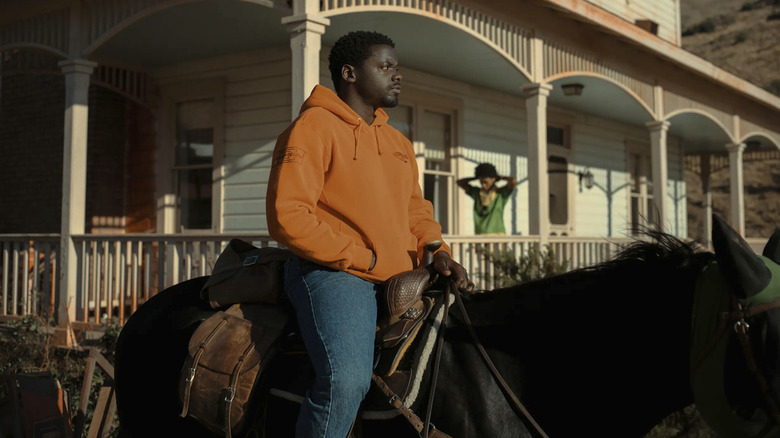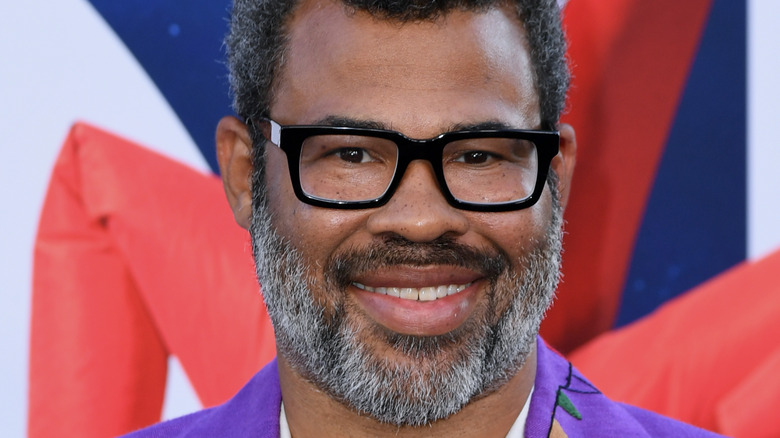Nope Editor Nicholas Monsour Tells What Grabbed Him Most About The Movie - Exclusive
Editor Nicholas Monsour has now worked on two feature films written and directed by Jordan Peele – "Us" and "Nope" — as well as several TV projects created or developed by the prolific comedian-turned-filmmaker. But even he was struck by the unique setting, characters, narrative, and themes of "Nope," Peele's third feature film overall and perhaps his most ambitious to date.
"I loved its cultural specificity," Monsour tells Looper in an exclusive interview. "I'm from LA and I've driven around and know people who've grown up in the suburbs or up in the Santa Clarita area. I love the specificity of that because you can get at much deeper, more universal truths often through real and researched specific types of characters and backgrounds."
"Nope" tells the story of siblings O.J. and Emerald Haywood (played respectively by Daniel Kaluuya and Keke Palmer), who are struggling to hold onto their family business — a ranch in a remote California valley that provides trained horses for Hollywood productions, following the death of their father. Their dad's mysterious demise is only the start of a series of bizarre incidents that lead the Haywoods to discover that their land is under threat from an alien object hiding in the clouds above.
Focusing on a lesser-known business that operates in the film and TV industry, and the only one of its kind owned and operated by a Black family, "Nope" touches on issues of race, class, and the pervasive effect of cameras in our everyday lives, all while telling a scary story that combines elements of "Close Encounters of the Third Kind," "Jaws," and other sci-fi and horror classics in a wholly original way. "It ticked a lot of the boxes of things I've always wanted to experiment with," says Monsour.
Nope combines the history of cinema with modern filmmaking
One of the key elements of "Nope" is the Haywoods' (fictional) assertion that an officially unidentified Black man riding a horse in the earliest known moving picture — shot by photography pioneer Eadweard Muybridge — is actually an ancestor of theirs. The backstory of the Haywoods' business and the forgotten history of Black cowboys in Hollywood both caught Nicholas Monsour's imagination.
"I loved [Peele's] inspiration with the Muybridge as a film nerd myself," says the editor. "There's a film by Thom Andersen called "Eadweard Muybridge, Zoopraxographer" that I love, that gets into some of the stranger conceptual ideas about where film came from and why it was developed the way it was."
Monsour adds that "Nope" wove together history, genre, and social commentary in what to him was a seamless whole. "Jordan was thinking about all of that, but seemingly very effortlessly and in a way that seemed to emerge from these characters in an organic way," he explains. "Plus, I've always been attracted to sci-fi and fantasies from the sociological side, as a weird distorted mirror through which you then get to see and think about the structure and conditions of your own life more clearly and critically."
The final piece of the puzzle for Monsour was knowing that he would be able to challenge himself as an editor while working with other talented craftspeople at the top of their game. "I'm always looking for a way to ... bring the most creative and thoughtful version of the craft I've been learning to it," he says. "Knowing some of the collaborators already, knowing I was going to get to work with [composer] Michael Abels again, and [production designer] Ruth De Jong, I knew the imagery and the material I was going to get to experiment with was going to be incredible."
"Nope" is in theaters now.

